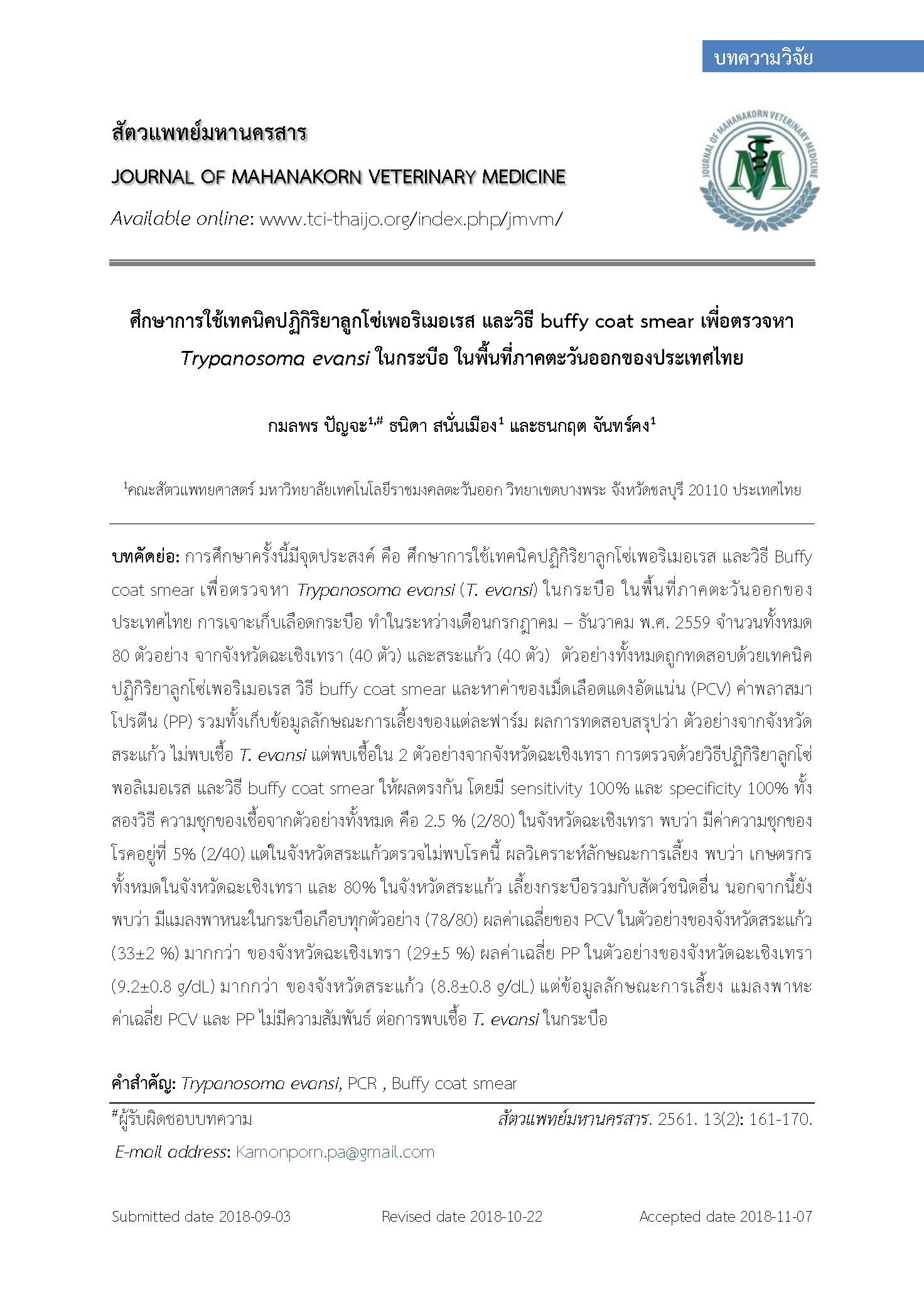Study on Using Polymerase Chain Reaction and Buffy Coat Smear Method for Trypanosoma evansi Detection in Buffalos of Eastern Thailand
Main Article Content
Abstract
The objective of this study was to study on using polymerase chain reaction (PCR) and Buffy coat smear method for Trypanosoma evansi detection in buffalos of eastern Thailand. Samples were collected from buffalo blood during July - December 2016. There were 80 samples; 40 samples from Chachoengsao province and the others were collected from Sa Kaeo province. All the samples were tested by PCR and buffy coat smear method. Packed cell volume (PCV) and plasma protein (PP) of samples were measured and data of husbandry management in each farm were recorded. Results from this study revealed that there was no T. evansi infection in sample from Sa Kaeo province. But, two infected samples of Chachoengsao province were found by both PCR and Buffy coat smear method. Therefore, PCR and buffy coat smear method had 100% sensitivity and 100 % specificity. The prevalence of all samples was 2.5% (2/80). Prevalence of Chachoengsao province was 5% (2/40) while the disease was not detected in Sa Kaeo province. Analysis of husbandry management showed that all of farmers in Chachoengsao and 80 % of farmers in Sa Kaeo province province raise buffalos with other animals. In addition, vector insects were found in almost all buffalos (78/80). The average PCV of samples in Sa Kaeo province (33±2 %) were more than those of Chachoengsao province (29±5 %).The average PP of Chachoengsao province (9.2±0.8 g/dL) were more than Sa Kaeo province (8.8±0.8 g/dL). However,data of husbandry management, vector insects, PCV and PP did not relate to found T. evansi infection in buffalos
Article Details
References
พิพล สุขสายไทยชะนะ. 2544. ศึกษาวิธี antigen detection ELISA ในการชันสูตรเชื้อ Trypanosoma evansi ในกระบือ. การประชุมทางวิชาการของมหาวิทยาลัย เกษตรศาสตร์ ครั้งที่ 39 สาขาสัตว์ สาขาสัตวแพทยศาสตร์: 316-320.
ไพทูล แก้วหอม. 2557. การใช้วิธีทางอณูชีวโมเลกุลตรวจหาเชื้อ Trypanosoma evansi ในเลือดโคและกระบือ. วารสารสัตวแพทย์มหานครสาร.9(1): 49-61.
มาณวิกา ผลภาค และสาทิด ผลภาค. 2556. การติดเชื้อ ทริปปาโนโซมา อีแวนซาย ในภาคตะวันออกเฉียงเหนือของประเทศไทย. วารสารสถาบันสุขภาพสัตว์แห่งชาติ. 8(2): 32-55.
วีรพล ทวีนันท์ เจษฎา จิกาวานนท์ สาธร พรตระกูลพิพัฒน์ เชี่ยวชาญ กระจ่างโพธิ์ พิทยา ภาภิรมย์ และวชิราภรณ์ กัมปวราวรรณ. 2544. ความชุกของทริปาโนโซมาอีแวนซัย ในฟาร์มโคนมและฟาร์มสุกรในเขตจังหวัดขอนแก่น. วารสารสัตวแพทยศาสตร์ขอนแก่น. 16(1): 53-58.
Flávia Howes Aleksandro Schafer Da Silva, Cristiane de Lima Athayde, Marcio Machado Costa, Marcos Matoso Burgo Corrêa, Kaio Cesar Simiano Tavares, Luiz Claudio Miletti, Sonia Terezinha dos Anjos Lopes, Anne Santos do Amaral, Anne Santos do Amaral and Claudete Schmidt. 2011. A New Therapeutic Protocol for Dogs Infected with Trypanosoma evansi. Acta Scientiae Veterinariae.39 (3): 1-4.
Ellah, M. R. A., A. Ellah, M. I. Hamed, D. R. Ibrahim, and H. Z. Rateb. 2013. Reference Values for Hematological and Serum BiochemicalConstituents in Buffalo's Heifers.International Congress of Mediterranean Federation of Health and Production of Ruminants, Assiut University, Egypt : Journal of Animaland Veterinary Advances.10 (6): 85-92.
Desquesnes, M., A. Dargantes, D. Lai, Z. Lun, P. Holzmuller, and S. Jittapalapong. 2013. Trypanosoma evansi and Surra: A Review and Perspectives on Transmission, Epidemiology and Control, Impact, and Zoonotic Aspects. BioMed Research International 2013 (321237): 1-20.
Mathieu, P. 2013. The effect of the DNA preparation method on the sensitivity of PCR for the detection of Trypanosoma evansi in rodents and implications for epidemiological surveillance efforts. Veterinary Parasitology. 191: 203-208.
Murrina. 2009. Surra (cited September 2015) :https://mysrf.org/pdf/pdfhttps://www.cfsph.iastate.edu/Factsheets/pdfs/surra.pdf,Institute for international Coorperation in animal: 1-5.
Sarataphan, N. 2012. Selection of Trypanosoma evansi Isolates for Antibody Detection in Cattle Deers Horses and Elephants using Agglutination Test. National Institute of Animal Health. 12(5): 1-10.
The World Organisation for Animal Health. 2012. TRYPANOSOMA EVANSI INFECTION (SURRA). OIE Terrestrial Manual: 314-323 https://www.oie.int/ fileadmin/Home/eng/Health_standards/tahm/2.01.21_TRYPANO_SURRA.pdf (cited MAY 2015).
Jittapalapong, S. 2009. Prevalence of Trypanosoma evansi Infection Causing Abortion in Dairy Cows in Central Thailand. Kasetsart Journal (Nat. Sci.) 43: 53-57.
Baticados, W. N., D. L. Castro and A. M. Baticados. 2011. Parasitological and PCR detection of Trypanosoma evansi in buffaloes from Luzon Philippines. Ceylon Journal of Science (Bio. Sci.) 40 (2): 141-146.


